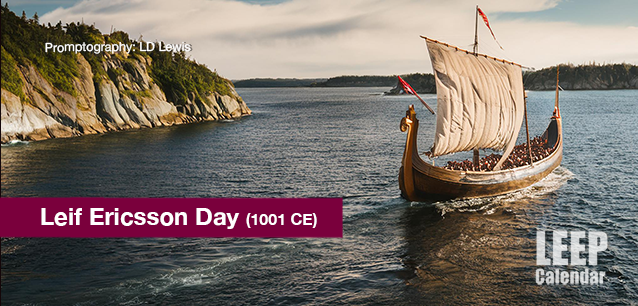 AD
AD
Today is: December 24
Scroll to explore events active on this date.
Additional Events on LEEP
LEEP INK FEATURES

August? Absolutely!
In August, we live through the Dog Days of Summer. It's hot and often humid, and those who can leave for better climates do. Down south, winter is in full force. August is also known as "the ...

In The Heat of July: July 2025 Events
Is it hot enough (or cold enough if you're below the equator) for you yet? There is actually a day for that! Like every month, I pick a diverse collection of events you may or may not know about. This ...

May Blooms: Events in May 2025
Along with October, May is one of the most densely packed months of the year. It's before the summer humidity and the last whole month of the school year. The weather is warming in t...
About Leif Ericsson Day
Culture & Art , United States
Ends: Oct 09, 2024
DESCRIPTION:
THE MAN WHO DISCOVERED AMERICA:
LEIF ERICSSON
Leif Ericsson, also known as Leif the Lucky, was a Norse explorer from Iceland and is often credited as the first European to set foot on North American soil, nearly 500 years before Christopher Columbus. Born around 970 AD, Leif was the son of Erik the Red, the founder of the first Norse settlements in Greenland. His explorations were part of the Viking expansion across the North Atlantic, which included Iceland, Greenland, and beyond.
Leif's most significant voyage occurred around 1001 CE when he sailed west from Greenland and reached a land he called Vinland, in present-day Newfoundland, Canada. This journey is documented in the Icelandic sagas, specifically the "Saga of the Greenlanders" and the "Saga of Erik the Red." According to the sagas, Vinland was named for the wild grapes found in the area and described as a fertile land with plentiful resources.
Leif's discovery of Vinland, which predates other European explorations of the New World by centuries, is a significant milestone in history. While the Vikings did not establish permanent settlements in North America, they briefly inhabited areas along the coast and engaged in trade with Indigenous peoples, thereby influencing the course of European exploration.
Leif Ericsson, a pioneering explorer, is celebrated for his journey that marked the farthest reach of the Norse expansion. His legacy is honored annually in the United States on October 9th, known as Leif Erikson Day. Though less widely known than later explorers like Columbus, Leif's achievements continue to inspire, serving as a testament to the daring and adventurous spirit of the Viking age.
Architecture has a long and rich history, evolving from ancient structures like the Egyptian pyramids and Greek temples to modern skyscrapers and eco-friendly buildings. Key architectural movements include Classical architecture, Gothic, Renaissance, Baroque, Modernism, and Postmodernism, each influencing the aesthetics and functionality of buildings across different eras. These movements have shaped physical spaces and cultural identities, symbolizing technological advancements and societal values.
VIDEOS
Currently, this event does not have supporting videos.
SUPPORTING DOCUMENTS
Currently, this event does not have supporting documents.
ADDITIONAL IMAGES
Currently, this event does not have supporting images.
Where would you like to go now?
 AD
AD


/footer-logo.svg)
